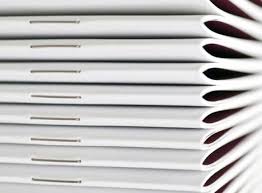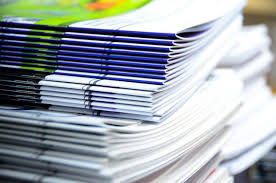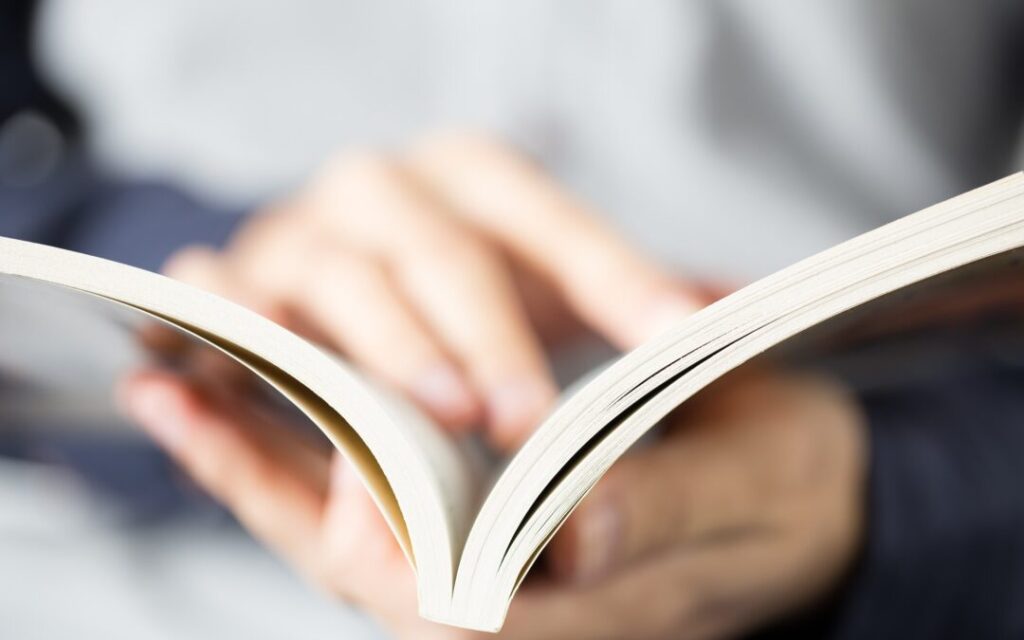
The choice of binding method can greatly affect the appearance, functionality, and cost of printed materials. A Saddle Stitch Binding Booklet and perfect binding are two prominent methods, each with distinct benefits and considerations.
The front cover plays a crucial role in booklet printing, impacting both the overall appearance and functionality of the booklet. Properly designing and uploading files for the front cover, along with other parts of the booklet, is essential to meet specific file requirements and ensure correct placement during production.
Saddle stitch, or stapled book printing, is a favored technique. It involves folding sheets in half and stapling them along the spine with wire staples. This method is ideal for booklets, reports, or catalogs up to 48 pages, offering a cost-effective solution. It’s especially suitable for publications like newsletters or magazines that require frequent updates.
Perfect binding, or adhesive binding, is the go-to for softcover books and other publications. This method glues the pages together along the spine, resulting in a polished look. Perfect binding allows for customization, including spine printing, and accommodates books with 60 to 400 pages.
Choosing between saddle stitched books and perfect binding hinges on several factors, including the desired appearance, page count, intended use, and budget. Understanding the strengths and limitations of each method can guide you in making a decision that meets your specific needs and preferences.
Introduction to Saddle Stitch Binding
Production of Saddle stitch books is a popular and cost-effective binding method used for booklets, brochures, magazines, and catalogues. This technique involves folding and stapling sheets of paper together along the spine, creating a strong and durable bond. Saddle stitch binding is ideal for small to medium-sized publications with a page count of up to 64 pages. Its simplicity and efficiency make it a go-to choice for many print projects, offering a professional finish without the high costs associated with other binding methods.
Understanding Saddle Stitch Binding
Saddle stitch binding, or stapled book printing, is a method where sheets are stacked and stapled along the fold. The saddle stitch binding method is ideal for brochures, programs, thin magazines, and booklets with up to 48 pages, offering advantages such as cost-effectiveness and ease of use. To optimize its use during the design stage, follow best practices like ensuring the page count is a multiple of four and using high-quality paper. This technique is both popular and practical.
What is Saddle Stitch Binding?

The process involves folding the booklet in half and stitching or stapling along the spine. Saddle-stitched booklets are known for their professional appearance and functionality, making them ideal for marketing materials and easy to read due to their flat-open design. This method ensures the pages are flush with the cover. However, it leads to “creep,” where pages shrink towards the book’s center. Despite this, it’s chosen for its affordability, quick turnaround, and broad availability.
How Saddle Stitching Works
The saddle stitching process involves several straightforward steps:
- Collating: The pages are arranged in the correct order and collated together, ensuring that the content flows seamlessly from one page to the next.
- Folding: The sheets are then folded in half, creating a crease in the middle. This fold forms the spine of the booklet.
- Stapling: Wire staples are inserted through the folded sheets along the spine, securing them together. This step is crucial for holding the pages in place.
- Trimming: Finally, the booklet is trimmed to the desired size, removing any excess paper and ensuring a clean, professional edge.
This method is efficient and effective, making it a preferred choice for many types of publications.
Pros and Cons of Saddle Stitch Binding
Its main benefits include being cost-effective, quick to produce, and versatile for creating brochures, catalogues, and small booklets. A saddle stitched booklet is particularly advantageous due to its cost-effectiveness and quick production time.
Yet, it has its downsides. The staples can loosen with more pages, and paper choices are limited since both sides of the fold are identical.
Ultimately, saddle stitch binding is perfect for budget-friendly, rapid production of booklets and brochures, especially for quantities under 500. It delivers a professional look without breaking the bank.
Saddle Stitch Binding Limitations
While saddle stitch binding is a versatile and cost-effective method, it does have some limitations:
- Page Count: Saddle stitch binding is best suited for publications with a page count of up to 64 pages. Thicker publications may require a different binding method to ensure durability and ease of use.
- Paper Thickness: The thickness of the paper used can affect the binding process. Thicker paper may require a stronger staple or a different binding method to ensure the pages stay securely in place.
- Design: The design of the publication should take into account the binding method. For example, the cover should be designed to accommodate the staples, and the inner pages should be laid out to minimize the impact of “creep,” where inner pages extend slightly beyond the outer pages.
Understanding these limitations can help you decide if saddle stitch binding is the right choice for your project.
Design Considerations for Saddle Stitch Booklets

When designing a saddle stitch booklet, several factors should be considered to ensure a professional and functional final product:
- Page Layout: The pages should be laid out in a way that takes into account the binding method. This means arranging the pages so they can be easily folded and stapled without disrupting the flow of content.
- Margins: Set the margins to allow for the staples and to prevent any important content from being lost in the binding process. Adequate margins ensure that text and images are not too close to the spine.
- Cover Design: The cover should be designed to accommodate the staples and provide a professional finish. Consider using a slightly thicker paper for the cover to enhance durability.
- Image Resolution: Ensure that the image resolution is high enough to produce clear and crisp images. Low-resolution images can appear blurry and unprofessional when printed.
By paying attention to these design considerations, you can create a saddle stitch booklet that looks polished and meets your needs.
The Perfect Binding Method

Perfect binding, known as adhesive binding, has been a staple since the 1930s. It involves gluing the pages together at the spine, resulting in a flat, professional look. This technique is perfect for books with 50 pages or more, outshining saddle stitching for larger volumes.
What is Perfect Binding?
The process begins with gathering the book’s pages, trimming the spine, and applying a strong adhesive like PVA. Next, the cover is wrapped around the book block, and the edges are trimmed for a uniform finish. This method is ideal for paperback books, directories, and any publication with over 96 pages.
Advantages and Disadvantages of Perfect Binding
- Advantage: Perfect binding offers a clean, professional look and allows for spine printing, enhancing visibility in bookstores and on shelves.
- Advantage: It’s a durable method, ensuring the book remains sturdy and long-lasting.
- Disadvantage: This binding is more costly and has a longer turnaround time compared to saddle stitch.
- Disadvantage: Perfectly bound books don’t lie flat, which can be a problem for certain uses like recipe books or instruction manuals.
Perfect binding is a favored choice for various printed materials, from children’s books and magazines to catalogs and brochures. Its professional look and durability make it a versatile and dependable option.
Saddle Stitch Binding vs Perfect Binding
Saddle stitch binding and perfect binding are two popular binding methods used for publications. While both methods have their advantages and disadvantages, they are suited for different types of publications.
- Saddle Stitch Binding: Ideal for small to medium-sized publications with a page count of up to 64 pages, saddle stitch binding is a cost-effective method that provides a strong and durable bond. It is perfect for booklets, brochures, magazines, and catalogs that require a quick turnaround and a professional finish.
- Perfect Binding: Best suited for thicker publications with a page count of over 64 pages, perfect binding involves gluing the pages together along the spine, creating a strong and durable bond. This method is ideal for paperback books, directories, and any publication that requires a polished, professional look.
In summary, saddle stitch binding is a popular and cost-effective binding method used for booklets, brochures, magazines, and catalogs. It involves folding and stapling sheets of paper together along the spine, creating a strong and durable bond. While it has some limitations, it is ideal for small to medium-sized publications with a page count of up to 64 pages. Perfect binding, on the other hand, is better suited for thicker publications, offering a more professional and durable finish for you brand. By understanding the strengths and limitations of each method, you can choose the best binding option for your specific needs.
Stitch Binding Booklet: An Economical Choice

Saddle stitch binding, or stitch binding booklet, is a budget-friendly option for smaller projects like pamphlets and thin magazines. It’s both cost-effective and eco-friendly, needing no glue and thus reducing waste. Plus, its quick production time makes it perfect for urgent projects.
A saddle stitched book is particularly suitable for projects with a lower page count and tighter budget, offering an attractive and appealing option depending on design choices and quality materials used.
This method is versatile, fitting a broad range of page counts from 8 to 72 pages. It’s ideal for various print projects. Using the same paper for both cover and interior pages can also cut down on costs.
When compared to perfect binding, saddle stitch is significantly cheaper due to fewer materials and labor needed. This makes it a go-to for those wanting professional-looking materials without the high cost. It’s ideal for creating affordable booklets, brochures, and magazines.
Moreover, saddle stitch offers quicker turnaround times than perfect binding, making it great for projects with tight deadlines. It’s particularly suited for booklets or magazines with 8 to 80 pages. The page count must be a multiple of 4, aligning with the binding process.
Factors to Consider When Choosing a Binding Method
When picking the right binding method for your booklets, several key factors are crucial. The page count and overall size of the booklet greatly affect the choice of binding options. Saddle stitch binding is ideal for booklets with up to 48 pages, ensuring they lie flat when open and closed. Saddle stitched booklets are a practical and aesthetically pleasing option for marketing materials, such as promotional brochures, and they provide a quick turnaround for urgent printing needs. Perfect binding, on the other hand, is suited for books with over 96 pages, offering a more durable and professional finish.
Page Count and Booklet Size
The page count and dimensions of the booklet impact its final look and usability. One option to consider is using a self cover, where the same paper is used for both the cover and inner pages, simplifying the printing process. Larger saddle stitch booklets might show “creep,” where inner pages stick out. This issue can be reduced by adding blank pages or changing the paper weight. Perfect bound books, however, handle a broader range of page counts without these problems.
Purpose and Budget
The purpose of the publication and the budget are vital when choosing a binding method. If the booklet must be read without using hands, options like wire-o or spiral binding are better. The budget also influences the choice, as it determines the most cost-effective binding solution that meets the project’s needs.
By considering these factors, you can pick the binding method that suits your booklet’s specific needs. This ensures a polished and functional final product.
Conclusion
When deciding between stitch binding booklet and perfect binding for your projects, several key factors come into play. These include page count, booklet size, purpose, and budget. Saddle stitch binding stands out for its cost-effectiveness and broad availability, making it perfect for smaller, budget-friendly projects. Yet, it has its limits regarding the maximum page count and customization options.
Perfect binding, in contrast, presents a more professional and durable look, enabling spine printing and greater design flexibility. However, this comes with a higher price tag and a longer production time.
Assessing your specific needs and evaluating the advantages and disadvantages of each binding method will help you make a well-informed choice. Whether opting for saddle stitch binding for its versatility and quick turnaround, or perfect binding for its extensive range and professional finish, the ideal binding option will ensure your booklets and brand look great and fulfill your requirements.
In the realm of booklet binding, there is no universal solution. By grasping the specifics of each binding method, you can select the best fit for your page count, booklet size, and overall objectives. With thoughtful consideration and the appropriate binding process, you can craft booklets that not only wow your audience but also effectively communicate your message.








